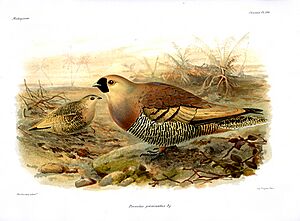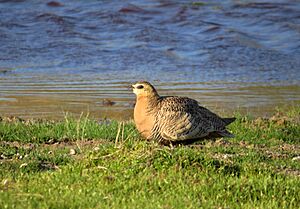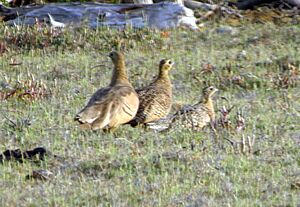Madagascar sandgrouse facts for kids
Quick facts for kids Madagascar sandgrouse |
|
|---|---|
 |
|
| Illustration of male | |
 |
|
| female | |
| Conservation status | |
| Scientific classification | |
| Genus: |
Pterocles
|
| Species: |
personatus
|
The Madagascar sandgrouse (Pterocles personatus) is a special type of bird that lives only on the island of Madagascar. It's a plump bird with short legs that spends its time on the ground.
Male sandgrouse have a brown head with a black area around their beak. Their chest is a pinkish-buff color, and their back is light brown with speckles. Their wings are brown, and their belly is lighter with dark brown stripes. Females look a bit duller, with brown feathers that help them blend in, covered in dark spots and stripes.
Contents
What Does the Madagascar Sandgrouse Look Like?
The Madagascar sandgrouse is a chubby bird with a short tail and short legs. It's easy to spot because both male and female birds have black feathers under their wings. This is the only type of sandgrouse found in Madagascar, so it's quite unique!
The adult male has a brown head with a clear black area around its beak. It also has a yellow ring of bare skin around its eye. Its back and rump are brownish-black with buff-colored speckles. The main flight feathers and tail feathers are brownish-black. The upper wing feathers are buff, and the tail has buff stripes and tips. The cheeks, neck, and upper chest are a pinkish-buff color, becoming white on the chin and throat. The lower chest has thin dark brown and buff stripes, which continue onto the belly, making it darker and more brownish-orange. Its beak is whitish, its eyes are brown, and its legs are grey.
The adult female doesn't have the black area around her beak. Instead, her head and the back of her neck are brownish-black with buff streaks. Her upper body is brownish-black with thin buff stripes and spots. Her tail is brownish-black with buff stripes and tips. Her chest is pinkish-buff with dark stripes on the sides. Her belly looks similar to the male's. Young sandgrouse look like the females, but their stripes are more brown than black, and their colors are generally softer.
Where Does the Madagascar Sandgrouse Live?
The Madagascar sandgrouse lives only on the island of Madagascar. You can find it in the drier southern and western parts of the country. It likes dry, open areas that are mostly flat, with grasses and not too many plants. This includes the spiny forests in the southeastern part of the island.
These birds visit water sources every day. You can often see them near stony riverbanks, lake edges, and on sandbars.
How Does the Madagascar Sandgrouse Behave?
Madagascar sandgrouse usually live in small family groups of three or four birds. Sometimes, they form larger groups of a dozen or more. During the day, they search for seeds on the ground. They walk around to find their food. They can run fast, but they don't do it very often.
These birds have excellent hearing and eyesight. They get scared easily, which makes it hard for people to watch them closely on foot. If they are disturbed, they might freeze at first. But soon, they will either sneak away or suddenly fly off. The whole group will fly together and land a short distance away. They talk to each other using a low, fast, rough sound like "ag-ag-ag-ag," or a single note repeated every few seconds.
In the early morning or late afternoon, they often gather at places where they can drink water. They might also drink at other times of the day. Sometimes, hundreds of them gather together to drink. They might rest on sandbanks during the day. When they drink, they sometimes walk into the water. They do this during the breeding season to carry water to their young in their wet chest feathers.
Reproduction and Life Cycle
Adult sandgrouse form pairs and stay together, even when they are in larger groups. Their nest is a shallow dip in the ground. They often make it next to a tree or bush, in a clump of plants, or among rocks. They line the nest with a few dried grasses, and sometimes a twig or a snail shell. Sometimes, they even decorate the nest with a ring of leaves around the edge, which they bring from other places.
They usually lay three eggs, which are greenish-brown with many dark brown spots. Both the male and female birds take turns sitting on the eggs to keep them warm. They will stay very still on the nest if someone comes near. They will only fly away when an intruder is about 10 meters (33 feet) or less from the nest.
Is the Madagascar Sandgrouse Endangered?
The Madagascar sandgrouse is listed as "Least Concern" by the IUCN Red List of Threatened Species. This means that it is not currently considered to be in danger of disappearing. It lives across a wide area in Madagascar and is common in the west and south of the country. It is less common further north. People do hunt it in some areas, but this is not thought to be a big threat to the species.



